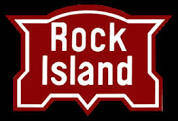Members of a Chicago, Rock Island & Gulf Railway survey crew pose on a flat car, c. 1902.
The crew worked in Arkansas, Oklahoma, and Texas. In Texas, they worked a ten-mile stretch between Dallas and Fort Worth.
Two of the crew members remained in the area and founded the town of Irving along the tracks in 1903.
(University of North Texas Libraries, The Portal to Texas History, https://texashistory.unt.edu; crediting Irving Archives. Cropped, corrected.)

CHICAGO, ROCK ISLAND AND GULF RAILWAY
The Chicago, Rock Island and Gulf Railway was a Texas subsidiary of the Chicago, Rock Island and Pacific Railroad. The railroad was chartered in 1902 with intention to construct a railway from Fort Worth, Texas to Galveston, Texas.

Two men in front of the Irving train depot. The Chicago, Rock Island & Gulf Railway built this depot in 1904.
(University of North Texas Libraries, The Portal to Texas History, https://texashistory.unt.edu; crediting Irving Archives. Cropped, corrected.)
History
The Chicago, Rock Island and Gulf Railway Company was chartered on May 13, 1902, in the interest of the Chicago, Rock Island and Pacific Railway (Rock Island) to construct an extension of the Rock Island system from Fort Worth to Galveston. It had a capital stock of $15,000,000. The principal place of business was Fort Worth. The members of the first board of directors were M. A. Low of Topeka; N. H. Lassiter, S. B. Hovey, Henry C. Holloway, F. E. Dietrich, and W. G. Newby, all of Fort Worth; and J. B. Wilson of Dallas.
In 1903 the CRI&G built thirty-two miles of track between Fort Worth and Dallas. No track was built south of Dallas, as the Rock Island eventually acquired a 50 percent interest in the Trinity and Brazos Valley in order to reach Houston and Galveston. In December 1903 the CRI&G acquired and merged three other Texas subsidiaries of the Rock Island. The Chicago, Rock Island and Mexico Railway and the Choctaw, Oklahoma and Texas Railroad operated lines in the Texas Panhandle, while the Chicago, Rock Island and Texas Railway ran between Terral, Oklahoma, and Fort Worth. The merger created a 334-mile system. An extension from Amarillo to the Texas-New Mexico border near Glenrio, New Mexico, was completed in 1910. At Glenrio the CRI&G connected with another Rock Island line to Tucumcari, New Mexico. A connection at Tucumcari with what later became the Southern Pacific completed a through route between Memphis and the Pacific Coast.
Class I Railroad
In 1916 the CRI&G owned fifty-five locomotives and 2,044 cars and reported passenger earnings of $848,000 and freight earnings of $2,476,000. In 1931 the line owned forty locomotives and 1,078 cars and reported passenger earnings of $778,000 and freight earnings of $5,500,000; that year it was listed as a Class I railroad.
No other major construction occurred until the late 1920s, when a series of new lines was projected for the Panhandle and adjoining states. The lines built included a route between Amarillo and Liberal, Kansas. The Texas portion opened as far as Stinnett in 1927 and was extended to Hitchland in 1929. Another Panhandle branch between Dalhart and Morse opened in 1930. In 1940 the CRI&G acquired the track of the Gulf, Texas and Western running seventy-five miles between Jacksboro and Seymour. However, the attempt to revive this line was unsuccessful, and it was abandoned in 1942.
The CRI&G was leased to its parent, the Chicago, Rock Island and Pacific Railway, on September 1, 1939. Both companies had entered receivership in 1933. The CRI&G was merged into the reorganized CRI&P on January 1, 1948, at which time the separate Texas organization ceased to exist. When merged, the CRI&G operated 732 miles of track that included the lease of ninety-six miles of the Burlington-Rock Island between Dallas and Teague.
Note: (Handbook of Texas, By: Nancy Young, Type: General Entry, Published: 1952, Updated: October 14, 2020)

